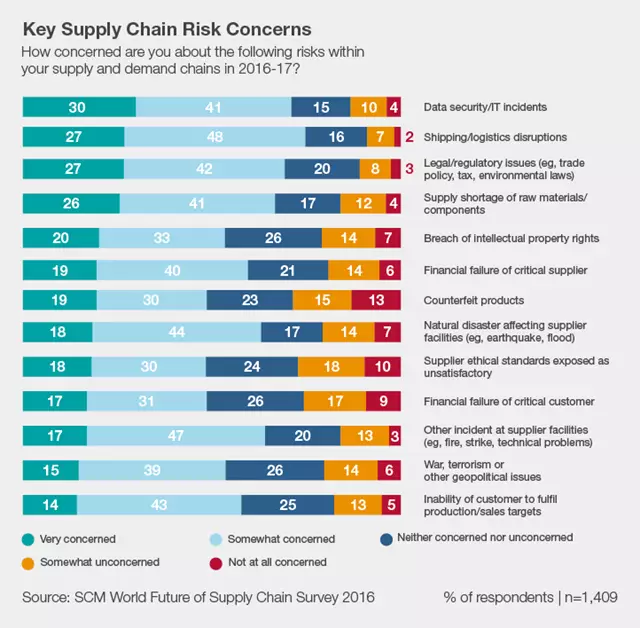How can spend analytics help mitigate supply chain risks?

Spend analytics is often simply defined as a procurement tool to generate cost savings. However, this approach can be extremely limiting as a strategic view of spend analytics opens up a much wider range of possibilities.
"84% of business leaders reported that forecasting risks is as difficult or more difficult as it was three years ago - AFP Risk Survey"
Beyond identifying savings opportunities, the enhanced visibility of a spend analytics platform can also help you to identify, monitor and mitigate supply chain risks. This new level of insight will enable your directors to sleep better at night, knowing that no matter what happens tomorrow, you’ll be able to confidently respond to any number of scenarios.
So what are these worst-case scenarios? Insight collected by SCM World in September 2016 put data security, shipping disruptions and regulatory concerns as the top three supply chain risk concerns.

Naturally, not every supply chain risk will be a concern for your organisation but that shouldn’t stop you from taking into consideration how you should respond if the need arises.
A study by the Business Continuity Institute uncovered the deep-rooted sources of supply chain failure. Respondents from various industries in 62 countries revealed that nearly 75% of organisations reported at least one supply chain disruption over the 12-month period studied.
I have seen many organisations spend a lot of money and time on implementing distinct systems to manage different risks. I believe this isn’t only a poor investment, but potentially dangerous. Standalone solutions can provide a limited view of risks, inhibiting response times.
This may explain why 84% of business leaders reported that forecasting risks is as difficult or more difficult as it was three years ago, according to the AFP Risk Survey, undertaken with Mercer. There is simply too much data to process and organise in a timely manner.
A number of procurement leaders I’ve spoken to are now taking a holistic approach supply chain risks, and creating detailed views of suppliers by bringing together disparate data sources. It’s logical, too, since procurement teams have been using spend analytics to understand their suppliers for years.
By simply adding additional types of data and information, they are able to centrally identify and manage financial, geo-political, natural disaster, compliance and reputational risks. All of this from one analytics hub, accessible by a variety of concerned internal stakeholders across departments.
From a foundation of spend analytics, with detailed visibility of your suppliers, let’s explore how you can mitigate a variety of business risks:
- Financial risks. Would you know when one of your key suppliers is facing bankruptcy? By understanding your supplier credit scores, and taking note when these take a downward trajectory, you will be able to prepare for and know when to switch providers of goods and services.
- Geo-political risks. Would you know when social unrest such as a major protest could prevent employees at one of your manufacturing sites from going to work? By incorporating social media into your analytics and using key words associated with your facilities, you will be alerted to potential problems in the efficient running of your operations overseas.
- Natural disaster risks. Would you know if a hurricane or an earthquake half way around the world could cause disruption to your supply chain? By knowing the location of your suppliers, and using real-time data from Google Earth, you would know when to inform other suppliers to increase production to meet your business requirements.
- Compliance risks. Would you know if your organisation is paying fraudulent suppliers? By identifying the linkages between suppliers and employees, including payments, you will be able to identify weakness in your accounts payable processes and cease any illegal behaviour.
- Reputational risks. Would you know if one of your suppliers is using slave labour to produce a product sold in your stores? By incorporating data from a third-party service provider, you will be able to determine if any company in your supply chain has been tagged as an employer of underage workers.
So, if you are looking to expand your spend analytics capabilities to include supply chain risk mitigation, how do you proceed?
The underlying foundation for analytics success is ensuring that you are working with accurate data you trust. This will require a spend analytics solution that provides data quality tools such as the ability to cleanse, normalise, classify and enrich supplier names and related details.
Once you have completed this phase (which must be reviewed on an ongoing process since data should be regularly updated, not static), then consider attaching geo-location, credit scores (provided by Dun & Bradstreet or Equifax) and other sources of information to your supplier records in order to obtain more visibility into your supply chain and potential risks.
Proactively identifying supply chain risks need not be an expensive project. If you’re already using spend analytics to manage suppliers, then you’re already well on your way.